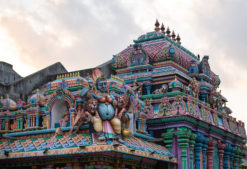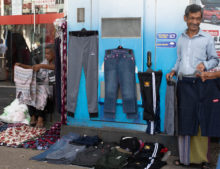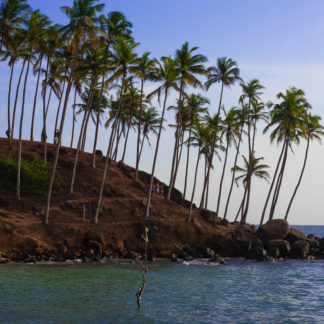Culture in Sri Lanka
The rich, diverse culture in Sri Lanka, is something you ought to experience. We can give you a never ending list of reasons to visit Sri Lanka. A list that comes with beaches, treks, wildlife and most importantly, its culture. Sri Lankan culture is the perfect blend of modernism, yet deeply rooted in tradition. Religions like Hinduism, Buddhism and Islam, strongly influence Sri Lankan culture. This vibrant culture with different customs, rituals and religions, makes it a much sought after tourist attraction. Another notable feature is the Indian (as a result of its proximity), European (due to the invasion of the Dutch), the Portuguese and the British influence.
The different customs, festivals, art forms, architecture and local cuisine, reflect the diverse culture of the country. Sri Lanka is also one of the friendliest countries, as hospitality and kindness are prominent characteristics of their culture. Here’s what to know before visiting Sri Lanka.
 The Temple of the Tooth Relic. The rich diverse culture of Sri Lanka has existed for years.
The Temple of the Tooth Relic. The rich diverse culture of Sri Lanka has existed for years.
Religion
Over 70% of the Sri Lankan population is Buddhist. The Tooth Relic at Kandy is perhaps the world’s most revered Buddhist heirloom. Other than that, Hinduism is a religion that’s dominant with the region’s Tamilians, the rest being Christians. Important Shiva Temples (one of the three Gods of Hinduism) are present all around the island. Some of the best temples are in cities like Chilaw, Colombo, Trincomalee, Jaffna. The island’s foremost Christian center of pilgrimage is in the north, at Madhu. The miracle-working statue of Our Lady of Madhu is the highlight of this region. The Muslims are mainly found along the West and East coasts of the country.
Followers of all four religions visit one another’s places of pilgrim and jointly participate in religious festivals. The pilgrimage town of Kataragama is proof of the peaceful coexistence among different religions . The town is famed for having a Hindu temple, a Buddhist stupa and a Mosque sitting side by side. This makes it one of the unique places to visit in Sri Lanka. Another fascinating example is the sacred mountain of Adam’s Peak. Buddhists, Hindus, Muslims and Christians have claimed the mountain’s mysterious “footprint”. They all believe that it was made, by the Buddha, Shiva, Adam and St Thomas respectively. This further highlights how people of various religions live together in harmony.
 The Kali Temple in Trincomalee. A Hindu temple with the most beautiful and intricate architecture.
The Kali Temple in Trincomalee. A Hindu temple with the most beautiful and intricate architecture.
Language
The three official languages of Sri Lanka are Sinhala, Tamil and English. Sinhala is the native language of the Sinhalese people. They make up 70% of Sri Lanka’s population. It is widely spoken in the southern, western and central parts of the island. The Northern and Eastern parts of the island primarily speak Tamil. Which is a widely spoken language in southern India and is popular among the Tamilian Hindus and Christians in Sri Lanka. The Malaysian Muslims in Sri Lanka speak Creole Malay, a mix of Bahasa Malaysia, Tamil, Sinhala and Arabic.
Majority of the Sri Lankans are well-versed with English, despite the existence of a variety of local languages. So communication barriers is the least of your issues. Though the local English is essentially British, comprehension may be a problem. Given the native accent and influence of local languages which cause a slight gap of understanding.
 Most locals can communicate in basic English, especially the younger generations. Thus, a communication barrier is the least of your worries.
Most locals can communicate in basic English, especially the younger generations. Thus, a communication barrier is the least of your worries.
Food
If exploring various types of cuisine is one of the reasons you travel, you’re in for a treat with local Sri Lankan food. The island’s exotic food is a vital aspect of its culture, with Rice and curry being the staple food in Sri Lanka. Mildly spiced flavors and coconut milk are key ingredients of Sri Lankan curries. The types of curries vary from meats, poultry and fish curry to vegetable and even fruit curries. Sambols, fresher concoctions made either with coconut or leaves, are a common accompaniment. Pappadam is another common accompaniment that you must try.
One distinct feature of their cuisine is that the same food is made differently in different regions. Dishes from the Southern region of the island can be spicy or mild. Another dish worth trying in Sri Lanka is Ambulthiyal. It is a unique spicy fish preparation with thick gamboges “Goraka” paste. The Western region on the other hand, has strong foreign influences. Spices such as cloves, cardamoms, nutmeg and pepper are found in abundance. Especially throughout Kandy and Matale District in the Central region. Our favourite picks — Fish Ambul Thiyal, Kottu, Kukul Mas Curry, Gotu Kola Mallung (Salad), Pol Sambol, Wood Apple juice and Watalappan (popular dessert amongst the Muslims).
 Rice and Curry is one of the most popular Sri Lankan dishes. Accompanied with meat or eggs or veggies, you can never go wrong with this dish.
Rice and Curry is one of the most popular Sri Lankan dishes. Accompanied with meat or eggs or veggies, you can never go wrong with this dish.
Festivals
Festivals are an integral part of the Sri Lankan culture. Home to the four main religions of the world, it is a land of never ending festivals and events, celebrating every aspect of life. Large parades along the streets is a popular means of celebrating prominent festivals in the country. It’s a lovely sight to witness with colorful dancers, drummers and elephants. The most famous festival that includes such celebrations is the Esala Perahera in Kandy. Mid April every year, the atmosphere in Sri Lanka is buzzing with festive excitement, making it the best time to visit Sri Lanka.
Amongst all the festivals, the Sinhala & Tamil New Year is celebrated with great pomp. It marks the end of the harvest season and spring. Vesak Poya is another prominent Buddhist festival. During this festival, cities like Colombo and Kandy sparkle with lit-up pandals, while tiny clay lamps brighten up villages. On the other hand, during Hindu festivals, like those at Kataragama and at the Nallur Kandaswamy Temple in Jaffna, devotees affirm their love for god. They do so by performing acts of self-mortification. They do this, because they believe that their god protects them from all feelings of pain. Other festivals you should make sure you plan your visit around are, Poton (Mihintale and Anuradhapura) and Vel (Hindu festival, Colombo).
 The famous Esala Perahera festival celebrated in Kandy.
The famous Esala Perahera festival celebrated in Kandy.
Customs & Etiquette
Sri Lankan customs and traditions are a result of history that dates back to the 17th century. They differ on the basis of religion and ethnic groups. The locals are expected to abide by these customs, but tourists are excused for obvious reasons. Sri Lankan culture has been stereotyped as narrow-minded and intolerant which is no more the case. With increase in tourism and urbanisation, tourists need not follow these customs. Yet, you should always ensure that you don’t disrespect it either.
At temples and other religious places, certain clothing etiquette has to be followed. Provisions are made at the Temple itself, for those who are unaware of these customs, . Scarves, long skirts and other essentials are usually available at the temple. People often ask, “What should I wear in Sri Lanka?”. Even though there are no restrictions in terms of clothing for tourists, as a mark of respect, one must cover their knees and shoulders.
 Make sure you follow certain clothing etiquette while visiting the temples and other places of worship in Sri Lanka.
Make sure you follow certain clothing etiquette while visiting the temples and other places of worship in Sri Lanka.
All in all, with its rich history, traditions and cultural diversity, there are several beautiful places in Sri Lanka you ought to visit. The culture in Sri Lanka is one of the many reasons it tops our list of travel destinations to visit. To understand the authentic Sri Lankan culture, one has to actually visit it and interact with locals who are more than willing to share. Their humility and happiness in contagious. And every time we visit the island, we feel welcome and as though we really belong. Whether its Sri Lankan homestays or local food chains. Longing to experience this warmth? Let’s start Planning your Sri Lankan Holiday.
helping you travel your way
We provide a helping hand to independent travellers who need assistance with planning and booking their trip. The primary goal is to turn your dream holiday into reality.








